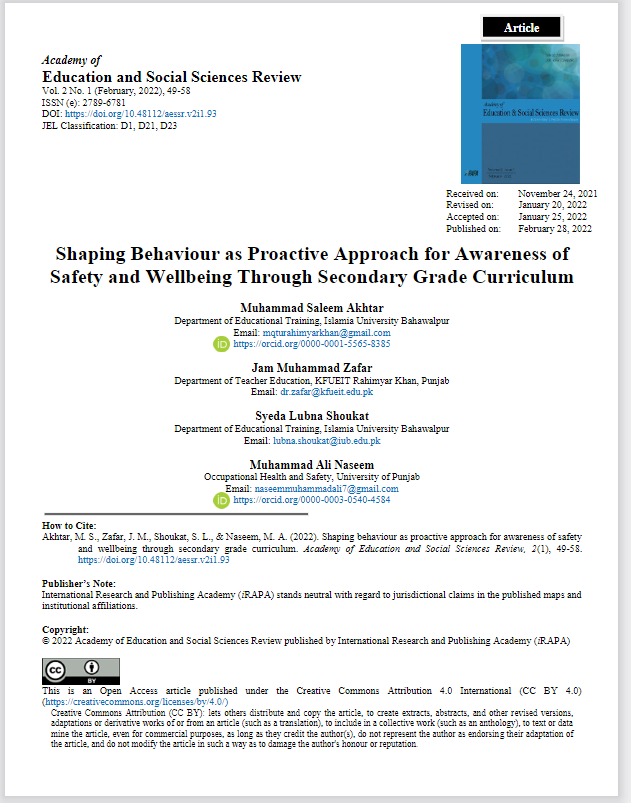Shaping Behaviour as Proactive Approach for Awareness of Safety and Wellbeing
Secondary Grade Curriculum
DOI:
https://doi.org/10.48112/aessr.v2i1.93Abstract
 Abstract Views: 271
Abstract Views: 271
The Shyness, reluctance, hesitation, and unawareness hamper to react in a safe way and may cause causalities. Usually children between the age of 13 to 15 get involved in road accidents due to carelessness. Safety awareness reduces the chances of accidents and injury happenings. A sample of 200 students and 99 teachers from secondary level public schools was taken. In order to develop awareness among secondary school students, action oriented SW instructional methods through hands-on-activities, experiential learning, labs, weather safety precaution, fire, electricity safety, and ways to motivate students to protect themselves and conserve their wellbeing were used. By using valid and reliable survey questionnaire and observation protocol, perceptions about SW were assessed after interventions and prominent awareness and behavioural changes were declared such as reduced number of accidents and injuries. The results are useful for the school administration and teachers to reflect on the inclusion of safety and wellbeing activities.
Keywords:
awareness, embarrassed, proactive approach, safety, shyness, wellbeingReferences
Baicker, K., Cutler, D., & Song, Z. (2010). Workplace wellness programs can generate savings. Health affairs, 29(2), 304-311. https://doi.org/10.1377/hlthaff.2009.0626
Baskerville, R., Spagnoletti, P., & Kim, J. (2014). Incident-centered information security: Managing a strategic balance between prevention and response. Information & Management, 51(1), 138-151. https://doi.org/10.1016/j.im.2013.11.004
Broadbent, R., & Papadopoulos, T. (2014). Improving mental health and wellbeing for young men in the building and construction industry. Journal of Child & Adolescent Mental Health, 26(3), 217-227. https://doi.org/10.2989/17280583.2014.923431
Clarke, S. (2013). Safety leadership: A meta‐analytic review of transformational and transactional leadership styles as antecedents of safety behaviours. Journal of Occupational and Organizational Psychology, 86(1), 22-49. https://doi.org/10.1111/j.2044-8325.2012.02064.x
Cooray, V., Cooray, C., & Andrews, C. J. (2007). Lightning caused injuries in humans. Journal of Electrostatics, 65(5-6), 386-394. https://doi.org/10.1016/j.elstat.2006.09.016
Costanza, R., Fisher, B., Ali, S., Beer, C., Bond, L., Boumans, R., ... & Snapp, R. (2007). Quality of life: An approach integrating opportunities, human needs, and subjective well-being. Ecological Economics, 61(2-3), 267-276. https://doi.org/10.1016/j.ecolecon.2006.02.023
Crawford, R. (2006). Health as a meaningful social practice. Health: An Interdisciplinary Journal for the Social Study of Health, Illness and Medicine,10(4), 401-420. https://doi.org/10.1177/1363459306067310
Cuellar, M. J., & Coyle, S. (2021). Assessing disparities in school safety: Implications for promoting equality in current efforts to keep kids safe. Security Journal, 34(4), 658-684. https://doi.org/10.1057/s41284-020-00254-2
Díaz-Vicario, A., & Gairín Sallán, J. (2017). A comprehensive approach to managing school safety: case studies in Catalonia, Spain. Educational Research, 59(1), 89-106. https://doi.org/10.1080/00131881.2016.1272430
Falavigna, A., Teles, A. R., Velho, M. C., Medeiros, G. S., Canabarro, C. T., de Braga, G. L., ... & Kleber, F. D. (2012). Impact of an injury prevention program on teenagers' knowledge and attitudes: results of the Pense Bem–Caxias do Sul Project. Journal of Neurosurgery: Pediatrics, 9(5), 562-568. https://doi.org/10.3171/2011.12.PEDS11169
Goldblatt, H. (2009). Caring for abused women: impact on nurses’ professional and personal life experiences. Journal of Advanced Nursing, 65(8), 1645-1654. https://doi.org/10.1111/j.1365-2648.2009.05019.x
Hoskins, D. H. (2014). Consequences of parenting on adolescent outcomes. Societies, 4(3), 506-531. https://doi.org/10.3390/soc4030506
Mariotti, A., & Hefti, A. F. (2015). Defining periodontal health. BMC Oral Health, 15(1), 1-18. https://doi.org/10.1186/1472-6831-15-S1-S6
Oah, S., Na, R., & Moon, K. (2018). The influence of safety climate, safety leadership, workload, and accident experiences on risk perception: A study of Korean manufacturing workers. Safety and Health at Work, 9(4), 427-433. https://doi.org/10.1016/j.shaw.2018.01.008
Rheault, H., Coyer, F., & Bonner, A. (2021). Chronic disease health literacy in First Nations people: A mixed methods study. Journal of Clinical Nursing, 30(17-18), 2683-2695. https://doi.org/10.1111/jocn.15757
Richmond, S. A., Zhang, Y. J., Stover, A., Howard, A., & Macarthur, C. (2014). Prevention of bicycle-related injuries in children and youth: a systematic review of bicycle skills training interventions. Injury Prevention, 20(3), 191-195. http://dx.doi.org/10.1136/injuryprev-2013-040933
Schonert-Reichl, K. A., Oberle, E., Lawlor, M. S., Abbott, D., Thomson, K., Oberlander, T. F., & Diamond, A. (2015). Enhancing cognitive and social-emotional development through a simple-to-administer mindfulness-based school program for elementary school children: a randomized controlled trial. Developmental Psychology, 51(1), 52-66. https://doi.org/10.1037/a0038454
Wang, P., Wu, P., Wang, J., Hung-Lin, C., & Wang, X. (2018). A Critical Review of the Use of Virtual Reality in Construction Engineering Education and Training. International Journal of Environmental Research and Public Health, 15(6), 01-18. https://doi.org/10.3390/ijerph15061204

Downloads
Published
How to Cite
Issue
Section
License
Copyright (c) 2022 Academy of Education and Social Sciences Review

This work is licensed under a Creative Commons Attribution 4.0 International License.




















